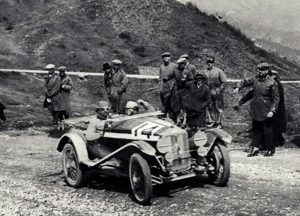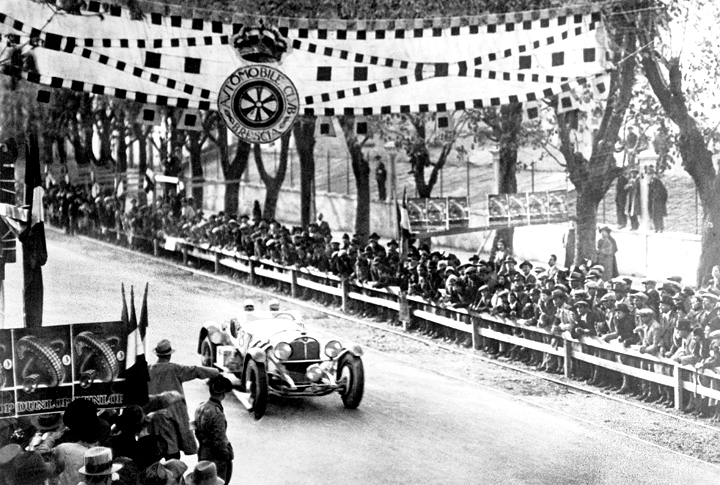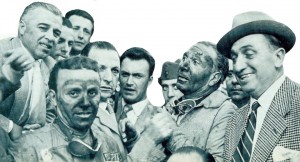Great Races that Changed the course of Racing History

Part 1 – The Mille Miglia
In the year 1927, two citizens of Brescia, Italy were drinking wine and soaking their sorrows, embarrassed that the driver from their fair town had lost the Italian Grand Prix race to a driver from Monza. These two came up with a crazy idea and sketched it out on a napkin : a race across Italy that would create the chance to re-capture some pride for their city. They settled on the idea of with a figure 8 shaped course from Brescia to Rome and back. The first time it was run, they had 75 Italians competing in the “1000 kilometer race” (Millle Miglia translated from Italian) and the winner from car constructor OM – Officine Mechanique took 21 hours to pass the finish line…. average speed of 48 miles an hour. Car numbers were given out as the car left the start line – Car 823 left at 8:23 that morning and there was no painters tape numbers on the sides of the car…which often made it hard to identify the competitors for the spectators and the other drivers. By the way, OM? That company was founded in 1899 and originally called Societa Anonima Officine Meccaniche. Later, it was called OM and then it finally became a part of a new company which we now call Fiat SPA.

In the 1930, a young race driver, Tazio Nuvolari, was trailing the leader in the dark of night. He turned off his headlights and tailed the leader for an hour. When he was within sight of the city of Brescia, he pulled up beside the leader, flashed his headlights. This surprised the leader who had not seen competition in many hours, and Tazio dusted him taking the win. The first recorded “Deceptive Moves in Motorsports History” award goes to Tazio. He went on to win a GP World Championship and later raced for Alfa Romeo, Ferrai, Maserati, and Audi.
In 1931, the race was won by a German named RudolfCaracciola – yes, he was German and his nickname was “Der Regenmeister”…or the Rain Master because of his “unique ability to slide his car through turns on wet pavement without braking and still retaining a high level of speed”. Yes. You are correct! Rudy was the world’s FIRST DRIFT king and he did it in a German car produced by a new family of car builders named Mercedes. Michael Schumaker later become famous for his rain talent and earned the name “Der Regenkonig”… or the Rain King. So, for the record… the FIRST drift car was not a Toyota, a Mitsu or even a Honda. The FIRST Fast and Furious “dorifto” car was an Pre-Benz Mercedes driven by “Keiichi ” Caracciola.![percorso-mille-miglia[1]](https://thesoutherndriver.com/wp-content/uploads/2011/09/percorso-mille-miglia1.gif)
The event was stopped in 1938 by Pre-war Mussolini after an accident killed a driver and a number of spectators. The race was started again in 1940 as the Grand Prix of Brescia.
There, a new Italian family introduced their car to the world – the AAC. That stood for Auto Avio Costruzioni. While their car did well, the race was won by a couple of Germans driving a car made in a city in the Bavarian part of Germany. That car? It was a BMW …and the AAC car that debuted there? That was another proud family of car builders known as Ferrari.
From 1947 until 1957, the race was mostly dominated by Ferrari. During these years, MANY Italian families began to want to build a car and compete with pride for their family name. They would buy a Fiat or British car chassis and drive train and modify it. Actually, they supercharged it. Yes! Once again, you are correct! They were the original first Boost tuners. Then, the family would HAND MAKE a car body. When I say hand made, they actually took sheets of metal and beat them out with hammers and lead shot bags on tree stumps that had been shaped, sanded and carved for that purpose. Each Italian family that competed knew they could not win and keep up with the big dollar corporate backed cars … BUT they could compete with style and flair of the body stylings they designed and fabricated. The entire family was actively involved in designing and fabricating and this was all done in secret. The FIRST Italian design studios or Think Tanks. Even today, Italian design studios are set up as a comfortable “homey” environment to produce better thinking and interaction of teams. Each year, the body styling became more and more beautiful and there were contests and awards for style and beauty beyond the race itself. When Mr. Ferrari saw these designs and tried to hire the best from those families to come work for him, family pride forced them to say “NO…NEVER! WE canna’ come work’a with you Mr. Ferrari! Your a’cars will’a never be as beooutiful as ours !” Why is all that important? Well, the small families that built these car bodies by hand stuck together and continued to make beautiful car bodies and complete cars. The families are famous today and have last names like :Lamborghini, Pinafarina, Maserati, Lancia, Bugatti, Bandini, and DeTomaso.

In 1957, a terrible crash took the life of two drivers and 12 spectators…others were seriously injured but survived. The crash was caused by a blown tire because a team, in their desire to win, neglected to change tires at a pit stop to save time. Not only was Ferrari sued, the tire manufacturer was sued and they both lost. The family that made the tires almost went out of business due to the bad publicity and financial impact from loss of customers. They withdrew from racing for many years. They did survive by focusing on a new approach to building a better reputation with the “modern driver” … making softer tire compounds for every day consumers. Tires that would grip better on gravel and wet roads in Italy. They began to market their company, NOT as a race tire company as they were known but as a consumer oriented tire company. They used actors and actresses of the big screen to advertise their product in magazines. They even produced a calendar of celebrity pictures each year. That calendar is still made by their company and sold world wide today. They carved out a great name for themselves in the tire industry. They were the FIRST MARKETING SPINMASTERS who turned a tarnished image of “the cause of disaster and death” into one the world loved as makers of safer tires and wonderful pinup calendars… and to think, it all started in 1872 with a nice 24 year old Italian bike tire engineer in Milan. That’s the year he decided to start a company to make car tires…and his name was Giovanni Battista Pirelli.
For several years after the tragic accident, the Mille Miglia race continued as a “road rally” at legal speeds. That effort collapsed as it was nothing like the excitement of the true Mille Miglia and was deemed by fans as a “poor substitute for the real race”. Spectators did not show and funding from sponsors stopped. Historically, this was important in that it showed the world that a sport, no matter how great and beloved, can disappear over night if it is tainted by tragedy and law suits… and that the safety of drivers and spectators is truly an important part of racing. All the fans love a winner and watching people risk their lives, but touch that experience with tragedy and everyone turns away so they can forget their part in it…especially the sponsors and their wallets.
Since then, the event has become the Mille Miglia Storica – a big show for the rich to parade the antique cars through the course coupled with a TSD Rally for historic cars only. Spectators come from all over to see the cars pass and it is an honor to be selected to drive or enter the MM car show. It is only for the best of the best. The Mille Miglia Museum in Brescia is a must for every Italian car lover and it is an incredible repository of information and artifacts from the history of the race and Italian motorcars. If you have the opportunity, go see the celebration for what many consider, one of the greatest races that was ever held and certainly one that …
Changed the Course of History.
______________________________________________________________________
Article by Ted Theodore
Copyright 2008 – No reprint without written consent of author and The Southern Driver
